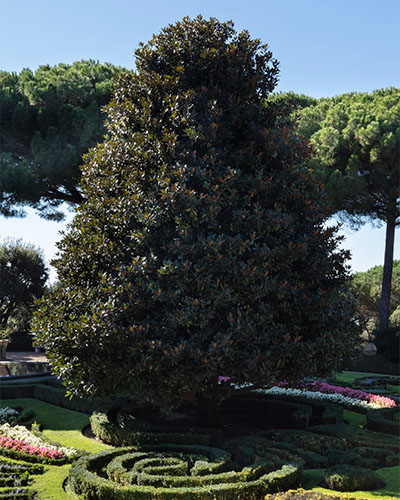Botany
Magnoliaceae
It is an evergreen tree, going up to 37 m tall, slow-growing, with a broad, conical-pyramidal crown. It has a simple and straight trunk with dark gray or light brown bark, which is rough and thick, and can reach a 1.5 m in circumference, with young reddish-tomentose twigs. Leaves are persistent, alternate, whole, but sometimes they present wavy edges, leathery, elliptical or ovate-oblong lamina, dark green and shiny above, pubescent-ferruginous on the underside, with a wedge base and a sharp apex, rarely obtuse. The actinomorphic flowers are very large and very fragrant, solitary and terminal, wrapped in bud by two large spacious bracts. The cup-shaped flower, not differentiated into sepals and petals, is formed by 6-12 free, obovate, pure white tepals, with a meaty and waxy consistency.
History
It is part of the Magnoliaceae family and comes from Central and North America and East Asia, especially Japan, where about 80 different species have been identified.
It is one of the oldest plants in the world. Fossil remains attest to its presence over 90 million years ago. In fact, it seems that following the Ice Age the only surviving Magnolias were those in America and Asia, and only thanks to British explorers was it possible to reunite them between the end of the 17th and 18th centuries. In 1688, Sir Bannister brought that unknown plant with deliciously fragrant flowers from America to England, where in 1703 it received the botanical name of Magnolia in honor of Pierre Magnol, a distinguished French botanist. Later on, at the end of the 1700s Sir Banks introduced the first Magnolia coming from the East, the Magnolia denudata. In Europe, the first Magnolia plants were grown in greenhouses, because they were considered very fragile and not very adaptable. However, it soon became the first largest and longest-lived outdoor plant grown in Europe, as the first specimen grown overseas lasted well over 100 years.
The Tree at Castelgandolfo
A Garden takes the name from this plant, the Magnolia Garden. It is a small but precious garden with baroque lines, surrounded by a hedge in boxwood pruned in balcony style, where it can be seen Pius IX’s coat of arms (eagle and three balls) also shaped in boxwood (var. microphylla), with vases of lemons and blooms of begonias and Ageratum sp. At the bottom, there is a fountain with a luxuriant presence of an aquatic fern, the maidenhair (Adiantum capillus veneris) completing the harmonious development of the spaces. A large Magnolia grandiflora in the middle balances and “oversees” the garden spaces.
General symbolism

According to the language of flowers, Magnolia means purity, dignity and perseverance. Seemingly, the Buddhist monks of central China cultivated the Magnolia denudata (also called Magnolia yulan) as early as the time of the T’ang dynasty (618-907 A.D.) and planted it all around their temples as a symbol of purity and openness.
It is the topic of many legends, but the most evocative is the one talking about the “two Magnolias”, explaining that the plant was made up of two parts, an external one, i.e. the body, and an internal one representing the soul and heart of the plant. One day, it fell in love with a yellow Azalea growing next to it. Not being reciprocated, its heart broke in two, detaching itself from the body. Thus, two trees were formed: the tall and strong Magnolia and the Star Magnolia with its white and fragile flowers. In Georgia, it is considered a symbol of good luck and economic stability; therefore, it is very often planted in house gardens. In Japan, instead, a legend has it that sleeping under a Magnolia tree could be deadly, due to its intense scent.
Medicinal importance
The oil extracted from its bark is able to lower blood pressure and regulate the heartbeat, giving a sense of well-being and relaxation. They are also used as anti-inflammatories and to counteract rheumatic problems. In the form of decoction or herbal tea, it is used in traditional Chinese medicine to treat various ailments, such as cough, asthma and digestive system problems, as well as anxiety, depression, stress and sleep disorders.
The bark contains the active constituents magnolol and honokiol. In vitro and in vivo studies have shown that these compounds have antimicrobial, anti-inflammatory, antidiabetic, antidepressant, anxiolytic and neuroprotective effects.
The Tree in the Pope mission
This tall, majestic and beautiful plant, with primitive and fragrant flowers, is one of the oldest plants in the world. It has faced glaciation and deforestation, climate change and earthquakes; and yet, it is still a plant existing on earth. It is a symbol of the Church overcoming the evils of the world.

